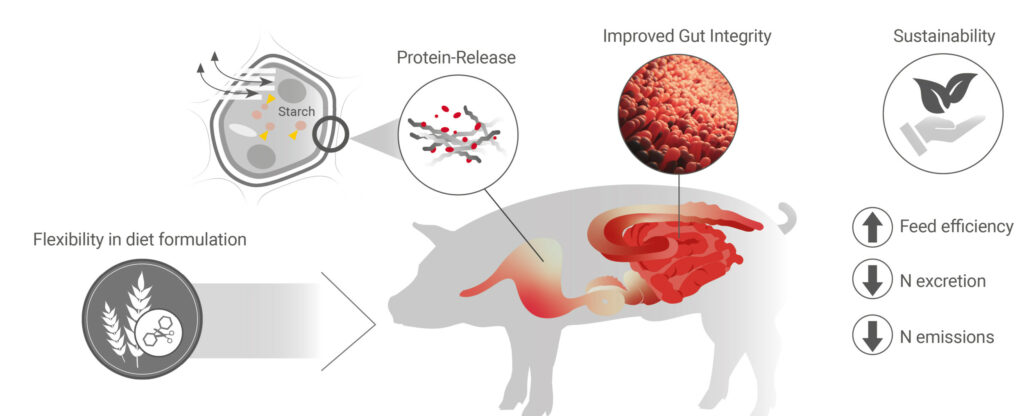Improve sustainability with a postbiotic of fungal fermentation

Together with sustainability and raw material availability, gut health is one of the major areas of interest for global feeding concepts. Products emerged from fermentation of plant substrates with fungi increase nutrient digestibility, animal performance, and contain functional metabolites strengthening gut integrity. Thus, diets can be uplifted or reformulated including a reduced crude protein content and related protein sources in the diet.
SUSTAINABILITY & WELFARE SPECIAL 2024 – read all articles
A long-term sustainability strategy in animal production requires viable feed solutions. Solid-state fermentation (SSF) is the cultivation of microorganisms on an inert carrier or insoluble substrate. In food processing, already thousands of years ago SSF was used as a processing technology to ferment rice with fungi in order to make it more shelf stable and to increase its nutritional value.
Increasing nutrient and energy digestibility
SSF products are also used in animal nutrition as a postbiotic ingredient produced by fermentation of plant substrates with fungi (e.g., Aspergillus spp., Neurospora spp. or Trichoderma spp.). The metabolites of the inactivated microbial cell components of this production process are part of the postbiotic effects of the SSF products, contributing to health benefits. Their main mode of action is illustrated in Figure 1 with the example of an SSF product especially targeted to protein release in monogastric diets, named Maxferm/Pro. Depending on the substrates and fungi used, SSF products show a variety of metabolic activities. The broad spectrum of residual enzymatic activity leads to the degradation of different carbohydrate structures within the diet matrix resulting in an increased nutrient and energy digestibility. The destabilisation and disintegration of fibre fractions releases cell wall-bound proteins to become available for endogenous proteases in the gastrointestinal tract.
Figure 1 – Fungal fermentation products increase nutrient digestibility and animal performance.

Postbiotic effects of SFF products
The achieved flexibility in uplift or re-formulation of diets strengthens the economic as well as ecological sustainability of different feeding strategies. The effects encompass savings of expensive raw materials which sometimes come along with long transport routes. The increased protein digestibility results in a possible reduction of the crude protein content of the diet. These measurements result in a reduced nitrogen excretion of the animals. Thus, ammonia concentrations in the barn air are lowered.
After successful proof of the efficacy and sustainability of the SSF products, let’s take a closer look on their postbiotic effects. As mentioned, SSF products contain metabolic and functional components that promote gut integrity. This was proven with the use of different methods and their results (Figure 2):
- The addition of the mycotoxin deoxynivalenol (DON) to a porcine IPEC-J2 cell culture from jejunal epithelial cells had a detrimental effect on the expression of tight junction proteins. This increased the permeability of the intestinal epithelium, resulting in the occurrence of a leaky gut. The simultaneous addition of a SSF product resulted in an upregulation of gene expression, leading to a lower overall risk of leaky gut and a strengthened intestinal barrier.
- The breakdown of easily fermentable carbohydrates by SSF products promotes desirable bacterial populations that positively affect animal health. This was shown by an increase in the number of beneficial lactobacilli and bifidobacteria in the microbial composition of broiler faeces when diets were supplemented with the SSF product. Also shown was the inclusion of a SSF product effectively lowered the adhesion of pathogens to epithelial cells (E. coli -77% and S. enterica -60%), thereby preventing pathogen entry into the cells and subsequent cell damage.
- Mycotoxins, such as DON, are known to affect epithelial cell migration, as the initial step in gastrointestinal wound healing. Results of a wound-healing assay using IPEC-J2 monolayers to mimic the porcine intestinal epithelium indicated that the treatment with DON clearly inhibited the wound healing processes. The addition of a SSF product was able to partially prevent or even completely salvage the detrimental effects caused by DON. Epithelial cells treated with a SSF product had an overall better fitness being better prepared for stressful rearing periods.
Figure 2 – Effects of SSF products on gut integrity by comparing a control group (left) with an SSF treatment (right).

Economic savings and more
Concluding, SSF products effectively increase nutrient utilisation of the animals, resulting in raw material savings and enhanced animal performances. The latter can be traced back to a facilitated health status of the animals, mainly caused by the postbiotic effects of the SSF products, especially the maintenance of the intestinal barrier against pathogenic invasion together with a great gastrointestinal wound healing capacity.
All technical statements are based on scientific literature and trial results; references and trial details are available upon request.







